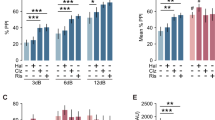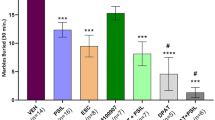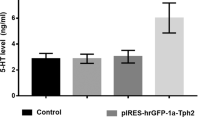Abstract
The serotonergic system is involved in the modulation of prepulse inhibition (PPI) and habituation of startle, which are deficient in schizophrenia patients. PPI is the reduction in startle amplitude that occurs when a weak “prepulse” precedes a startling stimulus by 30–500 msec. The roles of 5-HT1A and 5-HT1B receptors in modulating PPI and habituation were examined using wild-type (WT), 5-HT1A knockout (1AKO), and 5-HT1B knockout (1BKO) mice. The 5-HT1A/1B agonist RU24969 reduced PPI and habituation in WT and 1AKO, but not 1BKO mice, whereas the 5-HT1A agonist 8-OH-DPAT increased PPI in WT and 1BKO, but not in 1AKO mice. Similarly, the selective 5-HT1B agonist anpirtoline reduced PPI in WT, but not in 1BKO mice. In experiments using intact 129Sv mice, the 5-HT1A agonist flesinoxan increased PPI while anpirtoline decreased PPI and habituation. Findings suggest that 5-HT1B receptor activation decreases PPI and habituation, and 5-HT1A receptor activation increases PPI in mice.
Similar content being viewed by others
Log in or create a free account to read this content
Gain free access to this article, as well as selected content from this journal and more on nature.com
or
References
Baumann P, Bertschy G . (1997): Long-term treatment of depression: Is there a use for depot antidepressants? Intl Clin Psychopharmacol 12: 77–80
Bolino F, Di Michele V, Di Cicco L, Manna V, Daneluzzo E, Casacchia M . (1994): Sensorimotor gating and habituation evoked by electro-cutaneous stimulation in schizophrenia. Biol Psychiatry 36: 670–679
Boschert U, Amara DA, Segu L, Hen R . (1994): The mouse 5-hydroxytryptamine1B receptor is localized predominantly on axon terminals. Neuroscience 58: 167–182
Braff DL, Stone C, Callaway E, Geyer MA, Glick I, Bali L . (1978): Prestimulus effects on human startle reflex in normals and schizophrenics. Psychophysiology 15: 339–343
Braff DL, Grillon C, Geyer MA . (1992): Gating and habituation of the startle reflex in schizophrenic patients. Arch Gen Psychiatry 49: 206–215
Brunner D, Hen R . (1997): Insights into the neurobiology of impulsive behavior from serotonin receptor knockout mice. In Stoff DM, Mann JJ (eds), The Neurobiology of Suicide: From the Bench to the Clinic. New York, New York Academy of Sciences, pp 81–105
Cadenhead KS, Geyer MA, Braff DL . (1993): Impaired startle prepulse inhibition and habituation in patients with schizotypal personality disorder. Am J Psychiatry 180: 1862–1870
Caine SB, Geyer MA, Swerdlow NR . (1991): Carbachol infusion into the dentate gyrus disrupts sensorimotor gating of startle in the rat. Psychopharmacology 105: 347–354
Doods HN, Kalkman HO, De Jinge A, Thoolen MJMC, Wilffert B, Timmermans PBMWM, Van Zwieten PA . (1985): Differential selectivities of RU 24969 and 8-OH-DPAT for the purported 5-HT1A and 5-HT1B binding sites. Correlation between 5-HT1A affinity and hypotensive activity. Eur J Pharm 112: 363–370
Dulawa SC, Geyer MA . (1996): Psychopharmacology of prepulse inhibition in mice. Chinese J Physiol 39: 1–8
Dulawa SC, Hen R, Scearce-Levie K, Geyer MA . (1997): Serotonin1B receptor modulation of startle reactivity, habituation, and prepulse inhibition in wild type and serotonin1B knockout mice. Psychopharmacology 132: 125–134
Dulawa SC, Hen R, Scearce-Levie K, Geyer MA . (1998): Serotonin1B receptor modulation of prepulse inhibition: Recent findings in wild type and 5-HT1B knockout mice. Ann NY Acad Sci 861: 79–84
Geyer MA, Tapson GS . (1988): Habituation of tactile startle is altered by drugs acting on serotonin-2 receptors. Neuropsychopharmacology 1: 135–147
Geyer MA, Braff DL . (1982): Habituation of the blink reflex in normals and schizophrenic patients. Psychophysiology 19: 1–6
Graham FK . (1975): The more or less startling effects of weak prestimuli. Psychophysiology 12: 238–248
Grof P, Joffe R, Kennedy S, Persad E, Syrotiuk J, Bradford D . (1993): An open study of oral flesinoxan, a 5-HT1A receptor agonist, in treatment-resistant depression. Int Clin Psychopharm 8: 167–172
Hamon M, Lanfumey L, El Mestikawy S, Boni C, Miquel MC, Bolanos F, Schechter L, Gozalan H . (1990): The main features of central 5-HT1 receptors. Neuropsychopharmacology 3: 349–360
Heisler LK, Chu HM, Brennan TJ, Danao JA, Bajwa P, Parsons LH, Tecott LH . (1998): Elevated anxiety and antidepressant-like responses in serotonin 5-HT1A receptor mutant mice. Proc Natl Acad Sci USA 95: 15049–15054
Hen R . (1992): Of mice and flies: Commonalities among 5-HT receptors. Trends Pharmacol Sci 13: 160–165
Hoyer D, Pazos A, Probst A, Palacios JM . (1986): Serotonin receptors in the human brain. I. Characterization and autoradiographic localization of 5-HT1A recognition sites. Apparent absence of 5-HT1B recognition sites. Brain Res 376: 85–96
Kehne JH, McCloskey TC, Taylor VL, Black CK, Fadayel GM, Schmidt CJ . (1992): Effects of the serotonin releasers 3,4-methylenedioxymethamphetamine (MDMA), 4-chloroamphetamine (PCA) and fenfluramine on acoustic and tactile startle reflexes in rats. J Pharmacol Exp Ther 260: 78–89
Koch M . (1996): The septohippocampal system is involved in prepulse inhibition of the acoustic startle response in rats. Behav Neurosci 110: 468–477
Leishman DJ, Boeijinga PH, Galvan M . (1994): Differential effects of centrally-active antihypertensives on 5-HT1A receptors in rat dorso-lateral septum, rat hippocampus and guinea-pig hippocampus. Br J Pharmacol 111: 318–324
Mansbach RS, Geyer MA, Braff DL . (1988): Dopaminergic stimulation disrupts sensorimotor gating in the rat. Psychopharmacol 94: 507–514
Mansbach RS, Braff DL, Geyer MA . (1989): Prepulse inhibition of the acoustic startle response is disrupted by N-ethyl-3,4-methylenedioxyamphetamine (MDEA) in the rat. Eur J Pharmacol 167: 49–55
Marcinkiewicz M, Verge D, Gozlan H, Pichat L, Hamon M . (1984): Autoradiographic evidence for the heterogeneity of 5-HT1 sites in the rat brain. Brain Res 291: 159–163
Parks CL, Robinson PS, Sibille E, Shenk T, Toth M . (1998): Increased anxiety of mice lacking the serotonin1A receptor. Proc Natl Acad Sci USA 95: 10734–10739
Pazos A, Hoyer D, Dietl MM, Palacios JM . (1988): Autoradiography of serotonin receptors. In Osborne NN, Hamon M (eds), Neuronal Serotonin. New York, Wiley, pp 507–543
Pazos A, Probst A, Palacios JM . (1987): Serotonin receptors in the human brain. IV. Autoradiographic mapping of serotonin-1 receptors. Neuroscience 21: 97–122
Phillips TJ, Hen R, Crabbe JC . (1999): Complications associated with genetic background effects in research using knockout mice. Psychopharmacology 147: 5–7
Pompeiano M, Palacios JM, Mengod G . (1992): Distribution and cellular localization of mRNA coding for 5-HT1A receptor in the rat brain: Correlation with receptor binding. J Neurosci 12: 440–453
Ramboz S, Oosting R, Amara DA, Kung HF, Blier P, Mendelsohn M, Mann JJ, Brunner D, Hen R . (1998): Serotonin receptor 1A knockout: An animal model of anxiety-related disorder. Proc Natl Acad Sci USA 95: 14476–14481
Rigdon GC, Weatherspoon J . (1992): 5HT1A receptor agonists block prepulse inhibition of the acoustic startle reflex. J Pharmacol Exp Ther 263: 486–493
Saudou F, Amara DA, Dierich A, LeMeur M, Ramboz S, Segu L, Buhot MC, Hen R . (1994): Enhanced aggressive behavior in mice lacking 5-HT1B receptor. Science 265: 1875–1878
Scearce K, Kassir S, Lucas J, Castanon N, Segu L, Arango V, Hen R . (1997): Dopaminergic compensations in knockout mice lacking the serotonin 1B receptor. Abstr Soc Neurosci 23: 202.2
Schlicker E, Werner U, Hamon M, Nickel B, Szelenyi I, Gothert M . (1992): Anpirtoline, a novel, highly potent 5-HT1B receptor agonist with antinociceptive/antidepressant-like actions in rodents. Br J Pharmacol 105: 732–738
Schoeffter P, Hoyer D . (1988): Centrally acting hypotensive agents with affinity for 5-HT1A binding sites inhibit forskolin-stimulated adenylate cyclase activity in calf hippocampus. Br J Pharmacol 95: 975–985
Sills MA, Wolfe BB, Frazer A . (1984): Determination of selective and nonselective compounds for the 5-HT1A and 5-HT1B receptor subtypes in rat frontal cortex. J Pharmacol Exp Ther 231: 480–487
Sipes TA, Geyer MA . (1995): 8-OH-DPAT disruption of prepulse inhibition in rats: Reversal with (+)WAY 100,135 and localization of site of action. Psychopharmacology 117: 41–48
Sipes TE, Geyer MA . (1997): DOI disrupts prepulse inhibition of startle in rats via 5-HT2A receptors in the ventral pallidum. Brain Res 761: 97–104
Stark KL, Oosting R, Hen R . (1998): Novel strategies to probe the functions of serotonin receptors. Biol Psychiatry 44: 163–168
Swerdlow NR . (1995): Serotonin, obsessive compulsive disorder and the basal ganglia. Int Rev Psychiatry 7: 115–129
Swerdlow NR, Braff DL, Geyer MA . (1990): GABAergic projection from nucleus accumbens to ventral pallidum mediates dopamine-induced sensorimotor gating deficits of acoustic startle in rats. Brain Res 532: 146–150
Swerdlow NR, Caine SB, Braff DL, Geyer MA . (1992): Neural substrates of sensorimotor gating of the startle reflex: Preclinical findings and their implications. J Psychopharmacol 6: 176–190
Thorpe WH . (1956): Learning and Instinct in Animals. Cambridge MA, Harvard University Press
Tsou AP, Kosaka A, Bach C, Zuppan P, Yee C, Tom L, Alvarez R, Ramsey S, Bonhaus DW, Stefanich E, Jakeman L, Eglen RM, Chan HW . (1994): Cloning and expression of a 5-hydroxytryptamine7 receptor positively coupled to adenylyl cyclase. J Neurochem 63: 456–464
Vollenweider FX, Remensberger S, Hell D, Geyer MA . (1999): Opposite effects of 3,4-methylenedioxymethamphetamine (MDMA) on sensorimotor gating in rats versus healthy humans. Psychopharmacology 143: 365–372
Winer BJ, Brown DR, Michels KM . (1991): Statistical Principles in Experimental Design. New York, McGraw-Hill, Inc
Ying SW, Rusak B . (1997): 5-HT7 receptors mediate serotonergic effects on light-sensitive suprachiasmatic nucleus neurons. Brain Res 755: 246–254
Zhuang X, Gross C, Santarelli L, Compan V, Trillat A-C, Hen R . (1999): Altered emotional states in knockout mice lacking 5-HT1A or 5-HT1B receptors. Neuropsychopharmacology 21: 52S–60S
Acknowledgements
The authors acknowledge the generous gifts of flesinoxan from Solvay Pharma, and RU24969 from Roussel UCLAF. This work was supported by grants from the National Institute on Drug Abuse (R02DA02925 & R01DA09862–01), the National Institute of Mental Health (NIMH) P01MH48126–06, the National Alliance for Research on Schizophrenia and Depression (NARSAD), and the U.S. Veterans Affairs VISN22 Mental Illness Research, Education, and Clinical Center. S.C. Dulawa was supported by a predoctoral NRSA from NIMH (F31-MH12249–01). C. Gross was supported by a grant from NIMH (F32MH12364–01). M.A. Geyer holds equity interest in San Diego Instruments, Inc.
Author information
Authors and Affiliations
Rights and permissions
About this article
Cite this article
Dulawa, S., Gross, C., Stark, K. et al. Knockout Mice Reveal Opposite Roles for Serotonin 1A and 1B Receptors in Prepulse Inhibition. Neuropsychopharmacol 22, 650–659 (2000). https://doi.org/10.1016/S0893-133X(99)00164-5
Received:
Revised:
Accepted:
Issue date:
DOI: https://doi.org/10.1016/S0893-133X(99)00164-5
Keywords
This article is cited by
-
Sex-specific effects of psychedelics on prepulse inhibition of startle in 129S6/SvEv mice
Psychopharmacology (2022)
-
Serotonin 5-HT1B receptor-mediated behavior and binding in mice with the overactive and dysregulated serotonin transporter Ala56 variant
Psychopharmacology (2021)
-
Effects of combined 5-HT2A and cannabinoid receptor modulation on a schizophrenia-related prepulse inhibition deficit in mice
Psychopharmacology (2020)
-
Effects of chronic fluoxetine treatment on serotonin 1B receptor-induced deficits in delayed alternation
Psychopharmacology (2013)
-
Serotonin1A receptor deletion does not interact with maternal separation-induced increases in startle reactivity and prepulse inhibition deficits
Psychopharmacology (2011)



